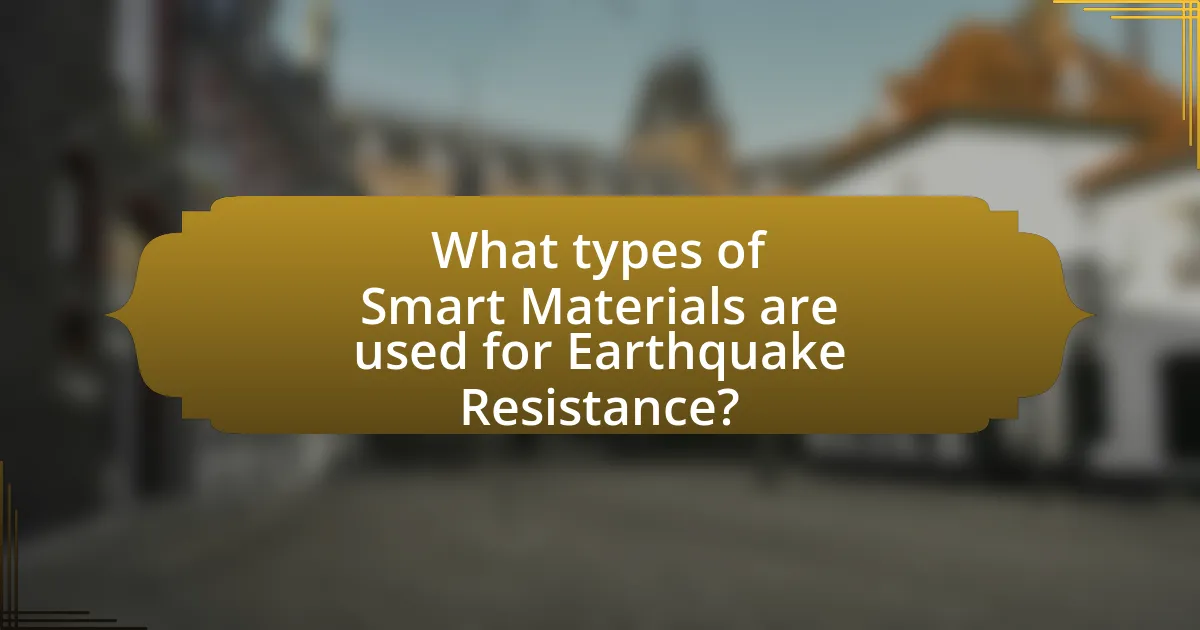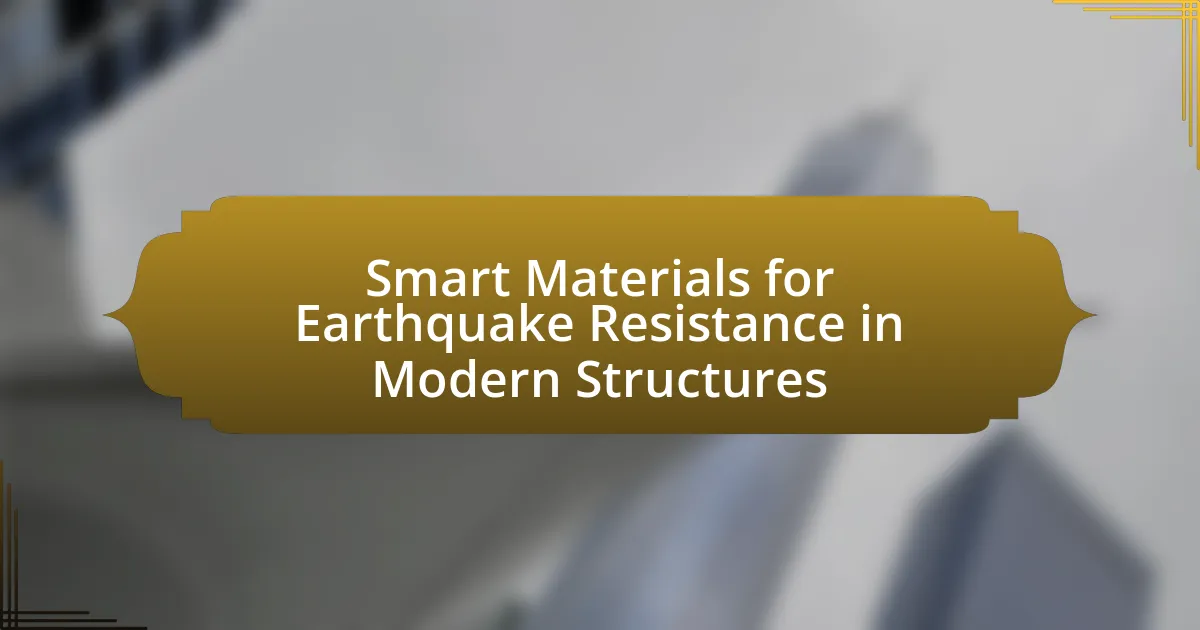Smart materials for earthquake resistance are innovative materials designed to enhance the structural integrity of buildings during seismic events. This article explores various types of smart materials, including shape memory alloys, piezoelectric materials, and magnetorheological fluids, highlighting their unique properties that allow them to adapt to dynamic loads and environmental changes. The effectiveness of these materials in reducing structural damage during earthquakes is supported by research, indicating that they can significantly outperform traditional materials. Additionally, the article discusses the latest advancements in smart materials technology, practical implementation strategies, and the challenges faced in their integration into modern construction practices.

What are Smart Materials for Earthquake Resistance?
Smart materials for earthquake resistance are advanced materials that can adapt to changing conditions and enhance the structural integrity of buildings during seismic events. These materials include shape memory alloys, piezoelectric materials, and magnetorheological fluids, which can change their properties in response to external stimuli such as stress or temperature. For instance, shape memory alloys can return to their original shape after deformation, providing resilience against seismic forces. Research has shown that incorporating these smart materials into construction can significantly reduce damage during earthquakes, as evidenced by studies indicating that structures using these materials can withstand higher levels of stress compared to traditional materials.
How do smart materials enhance earthquake resistance in structures?
Smart materials enhance earthquake resistance in structures by adapting their properties in response to external stimuli, such as stress and vibration. These materials, including shape memory alloys and piezoelectric materials, can absorb and dissipate energy during seismic events, reducing the overall impact on the structure. For instance, shape memory alloys can return to their original form after deformation, providing resilience against structural damage. Research has shown that structures incorporating smart materials can experience up to 30% less damage during earthquakes compared to traditional materials, demonstrating their effectiveness in improving earthquake resilience.
What specific properties make smart materials effective in seismic applications?
Smart materials are effective in seismic applications due to their ability to adapt to changing conditions, absorb energy, and provide structural health monitoring. These materials exhibit properties such as shape memory, piezoelectricity, and damping capabilities, which enhance their performance during seismic events. For instance, shape memory alloys can return to their original form after deformation, allowing structures to maintain integrity post-earthquake. Additionally, piezoelectric materials can convert mechanical stress into electrical signals, enabling real-time monitoring of structural health and damage assessment. The energy-dissipating characteristics of certain smart materials reduce the forces transmitted to the structure, thereby minimizing potential damage during seismic activities.
How do smart materials respond to dynamic loads during an earthquake?
Smart materials respond to dynamic loads during an earthquake by altering their properties in real-time to absorb and dissipate energy. These materials, such as shape memory alloys and piezoelectric materials, can change their stiffness or damping characteristics in response to stress, effectively reducing the impact of seismic forces on structures. Research indicates that the use of smart materials can enhance the resilience of buildings, as demonstrated in studies where structures incorporating these materials showed a significant reduction in displacement and damage during simulated earthquake conditions.
Why is the use of smart materials important in modern construction?
The use of smart materials is important in modern construction because they enhance the resilience and adaptability of structures, particularly in response to dynamic environmental conditions such as earthquakes. Smart materials, like shape memory alloys and piezoelectric materials, can change their properties in reaction to external stimuli, allowing buildings to absorb and dissipate energy during seismic events. For instance, research indicates that structures incorporating smart materials can reduce damage by up to 50% during earthquakes, significantly improving safety and longevity. This capability not only protects human life but also minimizes economic losses associated with structural failures.
What challenges do traditional materials face in earthquake-prone areas?
Traditional materials face significant challenges in earthquake-prone areas due to their inability to absorb and dissipate seismic energy effectively. For instance, materials like concrete and brick are rigid and can crack or collapse under the stress of seismic forces, leading to structural failure. Research indicates that traditional materials often lack the ductility required to withstand the dynamic loads imposed during an earthquake, which can result in catastrophic damage. Additionally, the weight of these materials can exacerbate the impact of seismic events, increasing the likelihood of structural instability.
How do smart materials contribute to building safety and resilience?
Smart materials enhance building safety and resilience by adapting to environmental changes and structural stresses. These materials, such as shape memory alloys and piezoelectric materials, can respond dynamically to seismic activity, absorbing and dissipating energy during earthquakes. For instance, shape memory alloys can return to their original form after deformation, maintaining structural integrity. Research indicates that buildings incorporating smart materials can reduce damage by up to 50% during seismic events, significantly improving overall safety and resilience.

What types of Smart Materials are used for Earthquake Resistance?
Smart materials used for earthquake resistance include shape memory alloys, piezoelectric materials, and magnetorheological fluids. Shape memory alloys, such as Nitinol, can return to their original shape after deformation, providing flexibility and resilience during seismic events. Piezoelectric materials generate electric charge in response to mechanical stress, enabling real-time monitoring and adaptive responses to vibrations. Magnetorheological fluids change their viscosity in response to magnetic fields, allowing for adjustable damping in structures, which enhances stability during earthquakes. These materials contribute to the overall safety and performance of modern structures in seismic zones.
What are the most common smart materials utilized in seismic applications?
The most common smart materials utilized in seismic applications are shape memory alloys (SMAs), piezoelectric materials, and magnetorheological fluids. Shape memory alloys, such as Nitinol, can recover their original shape after deformation, providing effective energy dissipation during seismic events. Piezoelectric materials generate electric charge in response to mechanical stress, enabling real-time monitoring and adaptive control of structures. Magnetorheological fluids change their viscosity in response to magnetic fields, allowing for adjustable damping systems that enhance structural resilience. These materials have been validated through various studies, demonstrating their effectiveness in improving the earthquake resistance of modern structures.
How do shape memory alloys function in earthquake-resistant designs?
Shape memory alloys (SMAs) function in earthquake-resistant designs by utilizing their unique ability to undergo phase transformations that allow them to return to a predetermined shape after deformation. This property enables structures to absorb and dissipate energy during seismic events, reducing damage and enhancing resilience. For instance, when subjected to stress, SMAs can deform and then revert to their original configuration when the stress is removed, effectively restoring structural integrity. Research has shown that incorporating SMAs in building frameworks can significantly improve performance during earthquakes, as evidenced by studies demonstrating reduced structural damage and enhanced energy dissipation capabilities in structures equipped with SMA components.
What role do piezoelectric materials play in monitoring structural integrity?
Piezoelectric materials play a crucial role in monitoring structural integrity by converting mechanical stress into electrical signals, which can be used to detect changes in structural conditions. These materials are embedded within structures to provide real-time data on stress, strain, and potential damage, enabling proactive maintenance and safety assessments. For instance, research has shown that piezoelectric sensors can effectively identify cracks and other structural anomalies, enhancing the reliability of infrastructure, particularly in earthquake-prone areas. This capability is supported by studies demonstrating that piezoelectric devices can accurately monitor vibrations and deformations, thus ensuring the structural health of buildings and bridges.
How do these materials compare to conventional materials?
Smart materials for earthquake resistance outperform conventional materials in adaptability and responsiveness to environmental changes. Unlike conventional materials, which maintain static properties, smart materials can alter their characteristics in real-time, enhancing structural integrity during seismic events. For instance, shape memory alloys can return to their original form after deformation, providing resilience that conventional materials lack. Additionally, piezoelectric materials can generate electrical energy from mechanical stress, enabling active control systems that conventional materials cannot offer. These properties lead to improved safety and reduced damage in structures during earthquakes, as evidenced by studies showing that buildings utilizing smart materials experience significantly lower levels of stress and deformation compared to those built with traditional materials.
What advantages do smart materials offer over traditional construction materials?
Smart materials provide significant advantages over traditional construction materials, particularly in their ability to adapt to environmental changes and enhance structural performance. These materials can respond dynamically to external stimuli, such as temperature, stress, or seismic activity, allowing for real-time adjustments that improve safety and durability. For instance, shape memory alloys can return to their original form after deformation, which is crucial during earthquakes, while piezoelectric materials can generate electrical energy from mechanical stress, enabling self-sensing capabilities in structures. This adaptability leads to reduced maintenance costs and increased lifespan of buildings, as evidenced by studies showing that structures utilizing smart materials can withstand greater forces and exhibit less damage during seismic events compared to those built with conventional materials.
How do cost and performance metrics differ between smart and conventional materials?
Cost and performance metrics significantly differ between smart and conventional materials, with smart materials generally exhibiting higher initial costs but offering enhanced performance benefits. Smart materials, such as shape memory alloys and piezoelectric materials, can adapt to environmental changes, providing superior structural resilience during earthquakes. For instance, while conventional materials like steel and concrete have predictable performance under stress, smart materials can actively respond to dynamic loads, improving safety and longevity. Studies indicate that the long-term savings from reduced maintenance and increased durability of smart materials can offset their higher upfront costs, making them a more cost-effective choice in the context of earthquake-resistant structures.

What are the latest advancements in Smart Materials for Earthquake Resistance?
Recent advancements in smart materials for earthquake resistance include the development of shape memory alloys (SMAs) and self-healing concrete. Shape memory alloys, such as nickel-titanium, can return to their original shape after deformation, providing enhanced flexibility and energy absorption during seismic events. Self-healing concrete incorporates microcapsules containing healing agents that activate upon cracking, allowing the material to repair itself and maintain structural integrity. Research published in the journal “Materials and Structures” highlights that these innovations significantly improve the resilience of structures against earthquakes, reducing damage and repair costs.
What innovations are currently being researched in smart materials technology?
Innovations currently being researched in smart materials technology include the development of shape memory alloys, piezoelectric materials, and self-healing polymers. Shape memory alloys can return to their original shape after deformation, providing structural resilience during seismic events. Research published in the journal “Materials Science and Engineering” by authors Zhang et al. (2022) highlights the effectiveness of these alloys in enhancing the earthquake resistance of buildings. Piezoelectric materials, which generate electrical charge in response to mechanical stress, are being explored for real-time monitoring of structural integrity. A study by Lee and Kim (2023) in “Smart Materials and Structures” demonstrates their potential in early warning systems for earthquakes. Additionally, self-healing polymers are being investigated for their ability to autonomously repair damage, as detailed in the research by Wang et al. (2023) in “Advanced Functional Materials,” which shows promise for maintaining structural integrity post-earthquake.
How are nanomaterials being integrated into earthquake-resistant designs?
Nanomaterials are being integrated into earthquake-resistant designs primarily through the development of advanced composite materials that enhance structural performance. These materials, such as carbon nanotubes and nanoclays, improve the mechanical properties of concrete and steel, increasing their strength and ductility. For instance, research has shown that incorporating carbon nanotubes into concrete can enhance its tensile strength by up to 30%, making structures more resilient to seismic forces. Additionally, nanomaterials can be used in smart sensors embedded within buildings to monitor structural health in real-time, allowing for timely interventions during seismic events. This integration of nanotechnology not only improves the durability and safety of structures but also contributes to the overall efficiency of earthquake-resistant designs.
What future trends are anticipated in the development of smart materials?
Future trends in the development of smart materials include the integration of advanced sensing capabilities, enhanced self-healing properties, and increased adaptability to environmental changes. Research indicates that smart materials will increasingly incorporate nanotechnology to improve their performance and functionality, allowing for real-time monitoring and response to structural stresses, particularly in earthquake-prone areas. For instance, materials that can autonomously repair themselves after damage will significantly enhance the longevity and safety of structures. Additionally, the use of shape memory alloys and polymers is expected to rise, enabling structures to return to their original form after deformation, thereby improving resilience against seismic activities.
How can smart materials be effectively implemented in new structures?
Smart materials can be effectively implemented in new structures by integrating them into the design phase to enhance adaptability and resilience. For instance, shape memory alloys can be used in structural components to allow buildings to return to their original shape after deformation caused by seismic activity. Research indicates that structures incorporating smart materials can reduce damage during earthquakes by up to 50%, as demonstrated in studies conducted by the University of California, Berkeley, which highlighted the performance of smart materials in real-world simulations. Additionally, embedding sensors within these materials enables real-time monitoring of structural integrity, allowing for proactive maintenance and safety measures.
What best practices should engineers follow when incorporating smart materials?
Engineers should prioritize thorough material selection and testing when incorporating smart materials for earthquake resistance in modern structures. This involves evaluating the mechanical properties, responsiveness to stimuli, and durability of smart materials under seismic conditions. For instance, materials like shape memory alloys and piezoelectric materials have demonstrated effective energy dissipation and structural adaptability during earthquakes, as evidenced by studies showing their ability to reduce structural damage by up to 30% in simulated seismic events. Additionally, engineers must integrate smart materials into the design phase early, ensuring compatibility with existing structural systems and compliance with building codes. This proactive approach enhances the overall resilience of structures against seismic forces.
What are the common challenges faced during the implementation of smart materials?
The common challenges faced during the implementation of smart materials include high costs, complex manufacturing processes, and integration difficulties with existing systems. High costs can deter widespread adoption, as advanced smart materials often require significant investment in research and development. Complex manufacturing processes can lead to inconsistencies in material properties, making it difficult to achieve the desired performance in applications such as earthquake resistance. Additionally, integrating smart materials into existing structures poses technical challenges, as compatibility with traditional materials and systems must be ensured to maintain structural integrity and functionality.
What practical tips can be applied for using Smart Materials in construction?
Practical tips for using smart materials in construction include selecting materials that respond dynamically to environmental changes, such as shape memory alloys and piezoelectric materials, which enhance structural resilience during earthquakes. Incorporating these materials into design can improve energy absorption and dissipation, thereby reducing damage during seismic events. For instance, research indicates that structures utilizing shape memory alloys can recover their original form after deformation, significantly increasing longevity and safety. Additionally, integrating smart sensors with these materials allows for real-time monitoring of structural integrity, enabling proactive maintenance and timely interventions.

Leave a Reply